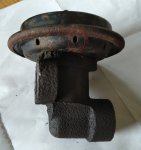Saucer_Face
New Member
- Joined
- May 20, 2021
- Messages
- 6
- Reaction score
- 0
- Points
- 1
- Location
- Canada
- Vehicle Year
- 2006
- Make / Model
- Ford Ranger
- Transmission
- Manual
Hi everybody,
New to forums, but I've been creeping them a long time. I just used a homemade smoke machine to check for vacuum leaks on my 2006 4.0L ranger. The only place leaking was at the EGR valve, at the holes circled in the picture below. I'm wondering if this is normal? These holes look like they were designed to vent after all. The smoke test was performed with the engine completely off and key out (if that makes any difference).
Every other test I've thrown at the EGR seems to indicate its working fine. It holds a steady vacuum, and when bench testing it, compressed air flows through the inlet to the outlet when vacuum applied. Is it still possible that it's bunk or leaking?
Thanks for any insight you guys can give.
New to forums, but I've been creeping them a long time. I just used a homemade smoke machine to check for vacuum leaks on my 2006 4.0L ranger. The only place leaking was at the EGR valve, at the holes circled in the picture below. I'm wondering if this is normal? These holes look like they were designed to vent after all. The smoke test was performed with the engine completely off and key out (if that makes any difference).
Every other test I've thrown at the EGR seems to indicate its working fine. It holds a steady vacuum, and when bench testing it, compressed air flows through the inlet to the outlet when vacuum applied. Is it still possible that it's bunk or leaking?
Thanks for any insight you guys can give.
Attachments
-
117.2 KB Views: 235















